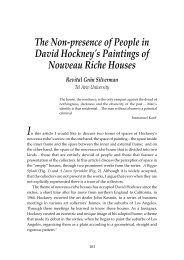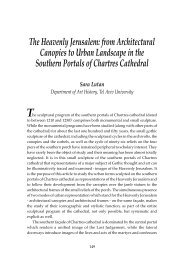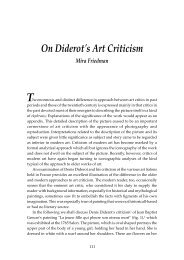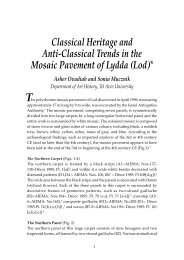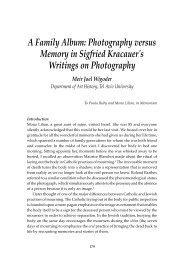Tumarkin's Homage to the Pietà Rondanini Avigdor WG Posèq
Tumarkin's Homage to the Pietà Rondanini Avigdor WG Posèq
Tumarkin's Homage to the Pietà Rondanini Avigdor WG Posèq
You also want an ePaper? Increase the reach of your titles
YUMPU automatically turns print PDFs into web optimized ePapers that Google loves.
assemblage is essentially different from that of its Renaissance pro<strong>to</strong>type against<br />
which he seems <strong>to</strong> react by using <strong>the</strong> modern techniques. The contrast is also<br />
reflected in <strong>the</strong> meaning of Tumarkin’s work. Moved by <strong>the</strong> sublime pathos of<br />
<strong>the</strong> <strong>Pietà</strong> <strong>Rondanini</strong>, Tumarkin associated himself with Michelangelo’s life-long<br />
quest for parental love; but, as a secular Jew, he is deprived even of <strong>the</strong> Italian<br />
master’s hope of finding it in death. Thus, ra<strong>the</strong>r than <strong>the</strong> yearned for o<strong>the</strong>r<br />
worldly bliss, <strong>the</strong> Israel Museum assemblage epi<strong>to</strong>mizes <strong>the</strong> misery of<br />
estrangement of its author and his inner need <strong>to</strong> alleviate his disorientation by<br />
relating his art <strong>to</strong> <strong>the</strong> sublime artistic tradition. However, his adaptation of <strong>the</strong><br />
Chris<strong>to</strong>logical motif has a deeper meaning which goes beyond that of his<br />
Renaissance model. While Michelangelo transformed a generic religious <strong>the</strong>me<br />
in<strong>to</strong> a personal allegory, <strong>the</strong> allusions <strong>to</strong> <strong>the</strong> traumatic experiences which<br />
Tumarkin shared with <strong>the</strong> rest of his generation elevate his au<strong>to</strong>biographical<br />
<strong>Pietà</strong> <strong>to</strong> <strong>the</strong> level of a transpersonal icon of <strong>the</strong> collective Jewish remembrance.<br />
The assemblage shows also that <strong>the</strong> Jewish character of a work need not be<br />
compromised by <strong>the</strong> reference <strong>to</strong> a non-Jewish iconographical motif, and that<br />
<strong>the</strong> work of a modern Israeli artist may be intensely personal and universal at<br />
<strong>the</strong> same time.<br />
NOTES<br />
This paper has been awarded <strong>the</strong> Hebrew Union College-Jewish Institute of<br />
Religion, in Jerusalem, Richard and Joan Scheuer Prize in Jewish Art and<br />
Architecture for <strong>the</strong> academic year 1995-96.<br />
1 The installation in 1987 of <strong>Tumarkin's</strong> work coincided with <strong>the</strong> Israel Museum<br />
publication of an illustrated catalogue of several of his assemblages with<br />
commentaries by M. Schneckenburger, art critic and direc<strong>to</strong>r of <strong>the</strong> 8th Documenta<br />
in Kassel, and Y. Zalmona, <strong>the</strong> Israel Museum cura<strong>to</strong>r for Israeli art, cf. Rails and<br />
<strong>Pietà</strong>. A version of <strong>the</strong> present paper was delivered as a lecture on: “Ambivalent<br />
Images of Son and Mo<strong>the</strong>r in Michelangelo and Tumarkin”, at <strong>the</strong> 17th Colloquium<br />
of <strong>the</strong> His<strong>to</strong>rical Society of Israel, Tel-Aviv, 1993.<br />
2 Michelangelo produced at least three sculptural versions of this subject. The “<strong>Pietà</strong><br />
<strong>Rondanini</strong>” is named after one of <strong>the</strong> early owners of this statue, which is now in<br />
<strong>the</strong> Castello Sforzesco in Milan; cf. Baldini, 142-147.<br />
3 Zalmona is right about “<strong>the</strong> tridimensional bodily solidity of <strong>the</strong> Renaissance<br />
sculpture” being replaced by what he calls “a two dimensional stage setting” but<br />
his description of <strong>the</strong> son as “a Karageöz shadow puppet” unnecessarily obscures<br />
<strong>the</strong> issue; Rails and <strong>Pietà</strong>.<br />
4 On <strong>Tumarkin's</strong> relation <strong>to</strong> <strong>the</strong> Parisian avant garde and on his innovative sculptural<br />
methods see: Tumarkin, 1970, 7-9. On his pioneering contribution <strong>to</strong> <strong>the</strong> new<br />
sculptural realism: Rails and <strong>Pietà</strong>.<br />
201



